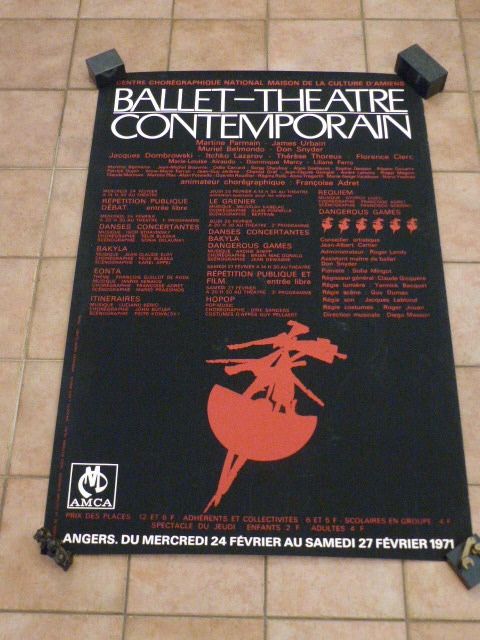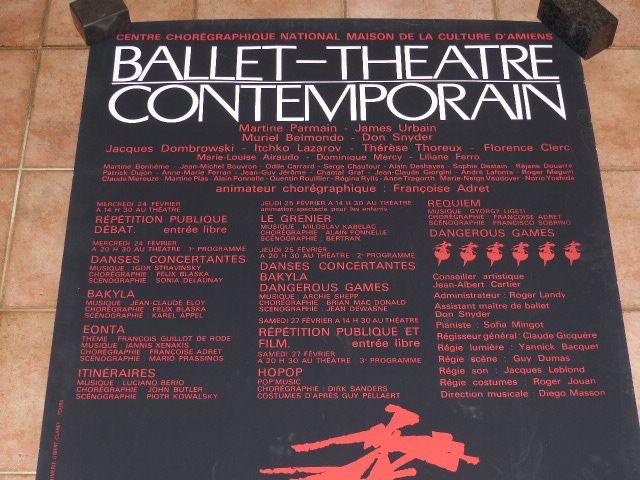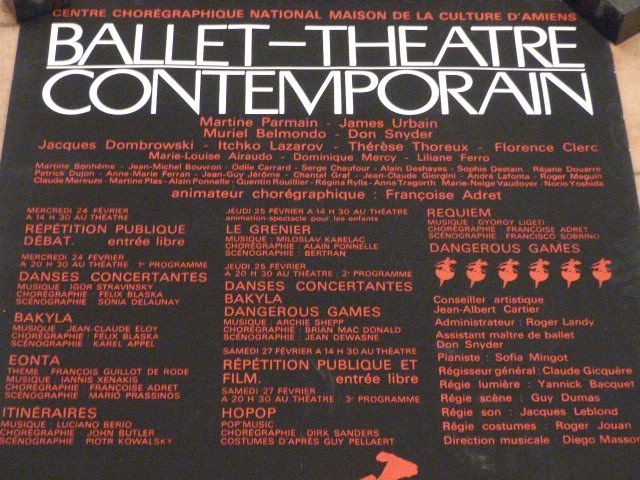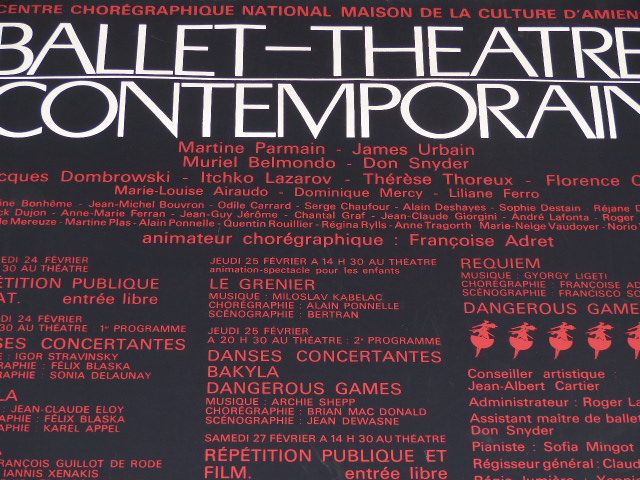Follow on ebay
at auction and in my shop "AmidesLivres"
an important set devoted to the Dance and Ballet, specifically
Opéra Garnier in Paris, in the 1980s/90s
Rudolf NOUREEV, Sylvie GUILLEM, PATRICK DUPOND, LAURENT HILAIRE,
MAURICE BEJART, Jerome ROBBINS
&CC...
PHOTOGRAPHS
BOOKS - VARIOUS DOCUMENTS - PROGRAMS - POSTERS
FROM THE PERSONAL COLLECTION OF
JOSSELINE LE BOURHIS
Josseline LE BOURHIS
Literary studies (license in classic and modern letters)
Simultaneously musical studies and University Theater
Master's degree in theater studies at the Sorbonne (Dramaturgy Section)
Public Relations, Information/Publications, Communication and Press Manager for the Maison de la Culture in Angers then the Maison de la Culture in La Rochelle and Dance Company "Théatre du Silence"
Assistant director at the Musical Theater of Angers
Programming - Dance in La Rochelle
From 1983 to 2002, Josseline LE BOURHIS was in charge of Dramaturgy and Publications
of Dance at the Paris Opera, and in particular with Rudolf Nureyev, Director of Dance from 1983 to 1989, and who had moreover wanted the creation of such a post
Also teaching, History of Dance at the CNSM of Lyon, collaboration on several films made on dance for the 5 and Arte and collaborations on several books on dance
-
[PHOTOGRAPHS]
argentique PRINT
Here we are starting the sale of the very many (several hundred)
Photographs present in the collection;
period prior to the presence of Josseline LE BOURHIS at the Paris Opera
concerning the very diverse shows (Music, Theater & Dance) in the organization of which she was able to participate: Maison de la Culture of Angers (68-74), Maison de la Culture of La Rochelle (after 1974), BTC, Theater of Silence, Avignon Festival 1970s,
&vs...
These photographs (unless otherwise stated) are all by Josseline LE BOURHIS , sometimes with her stamp and often with handwritten indications on the back
Largely unpublished, precious testimony of a intense period of cultural activity in France, after May 68...
I have for most of the photos only one copy,
so don't miss the opportunity...
You will find these photos in auction format on ebay,
and a large number of other photos at a fixed price for immediate purchase in my ebay shop
Please contact me for any questions
(my contact details at the bottom of the description sheets)
-
Size approximately 17.5x12.5cm
Vintage argentique print
Notes in pencil on the back
-
CCNMCA
Contemporary Ballet-Theatre
(as a guest company, before settling in Angers in 1972)
"HOPOP"
Pop music
The "Hopop" Ballet was created on November 14, 1969 in Amiens,
it is represented here in Angers in February 1971.
Choreography of Dirk Sanders. Scenography-sets of Caesar,
costumes according to Guy Peellaert.
Dancers:
Itchko Lazarov & Serge Chaufour
Saturday, February 27, 1971
1 date only for this Ballet
in Angers
[2]
(other photos of this Ballet for immediate purchase in my ebay shop...)
Angers
Municipal Theater
AMCA
(1968-1974)
BTC
Contemporary ballet-theatre
(Amiens 1968-1972, Angers 1972-1978)
The Contemporary Ballet Theater was created in 1968 on the initiative of the Ministry of Culture and placed under the artistic direction of Jean-Albert Cartier. Established successively in Amiens (1968-1972) then in Angers (1972-1978)
it became the Théâtre Français de Nancy in 1978.
Its vocation is to promote choreographic creation and to produce shows in collaboration
with contemporary musicians and painters.
In 1989 and 2004, Jean-Albert Cartier donated 66 sets and costume models by Sonia Delaunay, Tuan, Jesús-Rafael Soto, Karel Appel, Gérard Fromanger, Gustave Singier, Alexandre Calder, Francisco Bores, Edouard Pignon, Paul Charlot, Jean Dewasne, Emile Gilioli, Claude Viseux, Tal-Coat and Léon Zack for the productions of the Ballet Théâtre Contemporain from 1968 to 1978.
In Angers, the National Center for Contemporary Dance (CNDC), created in 1978 on the initiative
of the Ministry of Culture and the City of Angers will follow the BTC, transferred to Nancy
Conceived as a school for choreographers and headquarters of a permanent company
it will be directed by Alwin Nikolais for three years.
THE FIRST CHOREOGRAPHIC CENTER
HISTORICAL CHRONICLE
by Sylvain Bertoldi, chief curator of the Archives of Angers
Living in Angers, n° 406, Mars 2017
Before the opening of the National Center for Contemporary Dance (CNDC), the city of Angers was the seat, from 1972 to 1978, of the first National Choreographic and Lyric Center (CCLN) created in France by the Ministry of Cultural Affairs, around the Contemporary Ballet Theater (BTC) and the Musical Theater of Angers (TMA).
The Ballet Théâtre Contemporain, "one of the flag troupes of French dance" of the 1970s (Paul Bourcier, in Les Nouvelles littéraires), was founded at the Maison de la culture in Amiens on 1 September 1968 in the form of an association. It is the very first company of choreographic decentralization, centered on the creation of shows, the organization of “Knowledge of dance” days and meetings outside the Maison de la culture. Its goal is to be “the meeting point and simultaneous research” of body expression, plastic arts and contemporary music.
A kind of total art, wanted by its promoters, Jean-Albert Cartier (1930-2015) and Françoise Adret (1920). The first is not a dance professional: a former student of the Ecole du Louvre, journalist, art critic, assistant to the museums of Marseille, he approaches dance by personal taste in 1964-1967, as a choreographic critic for the Paris-Inter newspaper, before assuming administrative functions of coordination of cultural centers and drama centres. For her part Françoise Adret is a star dancer trained at the Franco-Russian school, interpreter of Serge Lifar. From 1951 to 1958, she directed the Amsterdam Opera Ballet, then worked for Roland Petit, the City of Nice and signed the choreographies of many international companies.
In three seasons, the twenty-one creations of the Ballet Théâtre Contemporain reach an audience of 300,000 people. Each year, a series of performances are held at the Théâtre de la Ville in Paris and on tour. This is how the Association Maison de la Culture d'Angers (AMCA) included the BTC twice in its very diversified cultural program, in February 1970 and 1971. In January 1971, the shows were preceded by an exhibition of the painters, sculptors and scenographers of the Ballet Théâtre Contemporain in the foyer of the Grand Théâtre: Sonia Delaunay, Mario Prassinos, Karel Appel, César, Jean Dewasne, Gérard Fromanger, Étienne Hajdu… The Angevins reserved at the Ballet an enthusiastic welcome: the ballet Hopop, "in its burlesque, is a kind of masterpiece", reported Le Courrier de l'Ouest on March 3 Mars 1971. He welcomes “a mode of expression that frees itself from the trappings of academicism and opens up deep and rich perspectives. [...] Fantasy, gaiety, youth, humor concluded the last evening in the friendliest, happiest and most playful way. Dirk Sanders' choreography sparkles with skill and intelligence. A whirlwind, a spirit that conquered the room. A firework, or rather, the crackling bouquet of this firework. The article concludes: “Here is the height of refinement and the mark of success: all this work gives you the idea of improvisation and natural ease in expression. »
Seduction works in both directions, because when the BTC begins to experience some "conflicts of temper" in Amiens after the change of municipality in Mars 1971 and the departure of the director of the Maison de la culture, he immediately thinks of settle in Angers. The city is attractive: JEUNE university, colleges, philharmonic orchestra and... sensitive and cultured mayor. “Our president, Francis Raison, directed us to Angers. Jean Turc was reputed to be one of the rare cultural mayors of our country, and I never ceased to notice it afterwards”, writes Jean-Albert Cartier in his book of memories, published in 2014 (Le Manteau d 'Harlequin, p. 142).
Discussions began in the summer of 1971 between Francis Raison, Jean Turc and Pierre Rouillard, his cultural assistant. Marcel Landowski, director of music, opera and dance at the Ministry of Cultural Affairs, is one of the linchpins of the negotiation. On January 4, 1972, in a private meeting, the city council gave its agreement to the arrival of the BTC, after long debates. The State has arguments that carry: two large subsidies from the Ministry of Cultural Affairs (2.2 MF) and the Ministry of Foreign Affairs (600,000 F). The municipality did not want to increase its cultural budget. The hesitant members of the council were rallied both by the arguments of Auguste Chupin – the reputation of the BTC will bring prestige to the city which will reflect on its industrial and university expansion – and by the warm and passionate plea of the mayor himself.
Angers had never had any institutions working in the field of dance, apart from the theater corps de ballet. In the field of education, several private "dance academies" dispensed their art to the Angevins. The most famous had been that of the Letournels, from 1880 to 1964. It was precisely Émile Letournel who, in 1930, had submitted to the municipality the project to create a municipal choreographic school. He had not been heard.
The "minister of culture" of Angers
On January 11, an official press release from the ministry announced the creation in Angers of the National Choreographic and Lyric Center (CCLN) bringing together the BTC and the Musical Theater of Angers. Pierre Barrat, director of the Musical Theater, is appointed to Strasbourg. Jean-Albert Cartier takes over the management of the whole, to which is added that of the theatre. He will therefore coordinate all of the establishment's programming, including concerts by the Orchester philharmonique des Pays de la Loire and the Society of Popular Concerts, Bacchi productions, the programming of the Maison de la Culture, Baret theater tours -Karsenty and variety tours.
A real “minister of culture” for Angers!
"The Contemporary Ballet Theater (from Amiens) comes to settle in Angers", Le Courrier de l'Ouest, December 14, 1971.
The "marriage" with the BTC is precisely "celebrated"... wedding hall of the town hall on January 22, 1972. The official photograph shows Jean-Albert Cartier, Jean Turc, the composer Roger Tessier – future creator of the Angers music festival of the 20th century – and Francis Raison, adviser to the Court of Auditors, chairman of the board of directors of the BTC. The mayor celebrates the culmination of many years of effort with which he associates the Maison de la culture d'Angers, capable of “deep assimilation into the population thanks to its desire to transform spectators into participants. The BTC will be able to “bring culture out beyond the cultural circles where it is often found. In conclusion, Jean Turc affirms: "The arrival of the Ballet Théâtre Contemporain with the OPPL, alongside the cooperation between Nantes and Angers, is the first stone of a real edifice created by the union of the troupe of the TMA and BTC. The arrival of the BTC is a big step in the cultural future of the Angevins. In my name, they welcome you, Monsieur Cartier”.
If the cooperation with Nantes for the music is indeed effective, as for the dance, it will never be. Indeed, the regional capital is quite unhappy to see the Ballet Théâtre set up in Angers, when it has set up its Atlantic Ballets on its own, without state aid. The two cities are in a competition that is hardly cordial. With the BTC, all the commentators even see Angers well placed to obtain a regional opera, following Marcel Landowski's plan for the creation of an opera by metropolis of equilibrium. The City is then the first lyrical scene from Calvados to Vendée and from Indre to Finistère, especially since Jean-Albert Cartier, contrary to the rumors which circulated on his arrival, not only continues the traditional lyrical seasons, but renovates and develops the operatic activity of the Théâtre musical d'Angers.
International fame
The BTC officially moved to Angers on July 1, 1972. He gave his first shows on May 30 and June 1, with Tribute to Diaghilev and Stravinsky. A public rehearsal attracts many young people: “It was with surprise and admiration that the public discovered the work of this team, which the choreographer Françoise Adret did not spare in any way” (Le Courrier de l'Ouest, June 1). The declaration in the prefecture (June 22) of the Center chorégraphique et lyrique national – Ballet Théâtre Contemporain clearly specifies the objectives: “To promote the establishment and development of choreographic and lyrical creation companies which are simultaneously places of meeting and research in the fields of visual arts, musical composition and lyrical and bodily expression. »
Creation is the main priority, choreographic and artistic, with the creation of costumes and sets. The state requires the company to produce four new shows a year. The corps de ballet is made up of six stars – three permanent and three guests – and twenty-four dancers, under the direction of Françoise Adret and her ballet master, Perey. Among the permanent star dancers, we can mention Martine Parmain and Muriel Belmondo, the sister of actor Jean-Paul Belmondo. The technical management comprises eight people, led by Claude Gicquère: a general manager, two light managers, a set manager, two costume designers, a sound engineer and a tour administrator.
The acronym of the National Choreographic and Lyric Center was that of the Musical Theater of Angers, created in 1968. It is due to the painter Tuan, who notably created the sets for the ballet “Le Rossignol” for the BTC.
On September 29, the BTC presents four of its great successes in Angers, before going on tour for “the Americas”: Danses concertantes, Nuits, Violostries and Hopop. The greatest artists have contributed to it: the composers Stravinsky, Xenakis and Parmegiani, the painters and sculptors Sonia Delaunay, Jesus-Rafael Soto and César, the choreographers Moshe Efrati, Michel Descombey, Dirk Sanders... “psychedelic”, writes the musical critic of the Courrier de l'Ouest, Joseph Fumet. This is the star ballet of the BTC [played 120 times since its creation in 1969]: Hopop has everything to please: insolence (musical), allegory (comics), gag (gestural). And a little more. Virtuosity makes everything pass, places the debate higher. […] Hopop retains an irresistible accent of youth and spontaneity. […] It's a pretty dazzling moment. […] The room was not as full as we had hoped. This is the only regret we will keep from this evening. BTC is perhaps the most serious business our city has ever hosted! »
The big business of BTC is creation, exchange with creators around the world. His work schedule includes two or three international tours a year, national tours and performances at the Théâtre de la Ville in Paris. At this rate, the Ballet is only present in Angers for a few months. But what interests the municipality is above all the international influence offered to it for the first time by the BTC. Until then, Angevin productions had hardly gone beyond the French framework, with the exception of a tour of the Musical Theater in London. Thanks to the company, the mayor has a national and international platform. He attended the premieres of the tours, in New York and Mexico. In six months, the BTC “has made the name of Angers travel more than any other tool since their creation” (Claire Frustoc, La Ville d'Angers et la danse de 1971 à 2005, p. 59).
Announcement of performances by the Ballet Théâtre Contemporain in Jakarta (Indonesia), during its major tour from Bombay to Hong-Kong, Singapore, Jakarta, Tokyo..., April 1974. Angers municipal archives.
Animation of shows
The BTC does not forget Angers. More than half of the company's eighteen creations during its stay in Angevin (1972-1978) premiered in Angers, such as the ballets Rags and Saints and Lovers, on January 17, 1975. But the very tight schedule of tours and performances does not allow him to devote himself fully to animation. Certainly, he has the will to lead a policy of active contact with all the actors of the cultural life of Anjou: School of Fine Arts, National School of Music, Tourist Office, bookstores... And on December 5, 1972, Jean-Albert Cartier presents to the prefect his project of departmental decentralization for 1973, by evenings and public rehearsals.
Reflection on cultural democratization and the social stakes of culture is, however, only at its beginning. It is mentioned in the cultural charter concluded between the City and the State on July 17, 1975. In the meantime, the City sees above all in the BTC an instrument of its prestige. As for the problem of the animation of its shows, it is solved thanks to the Association Maison de la Culture of Angers responsible for organizing public rehearsals and meetings. But this one does not accept being only the distributor of the productions of a hegemonic CCLN on the Angevin culture. The AMCA is also in difficulty. Its animation policy deemed “subversive” is displeasing and in the face of competition from the CCLN, its usefulness becomes less obvious. The CCLN provided the opportunity to remove the militants from the Maison de la Culture. In 1974, its funding was interrupted. The priority is not socio-cultural action, despite the ambitions declared and included in the cultural charter. At least the City wants to strictly frame it. The same year, it reformed the Festival d'Angers, suspended for a year and entrusted to Jean-Albert Cartier for transformation into a multidisciplinary Festival d'Anjou, which will have the advantage of being co-financed by the City and the General Council. The choreographic workshops that made the transition from the Angers festival to the Anjou festival in 1974 took up these socio-cultural ambitions.
What assessment?
The CCLN experience ended in 1978. Jean-Albert Cartier's contract is not renewed by the new municipality. Jean Monnier wants to keep the BTC, but wants to set up a new cultural policy by resuscitating a Maison de la Culture with the mission of coordinating the various cultural organizations. The direction of the theater must therefore be withdrawn from Jean-Albert Cartier. However, he wrote in his memoir, "I could not continue to operate the Ballet, the opera and the festival that had been entrusted to me in the meantime, without the main place where most of the work took place. my activity, the theatre. (The Harlequin Coat, p. 215). He therefore left the city for Nancy, called by the mayor to direct the opera there and to create a new corps de ballet, the Ballet Théâtre Français.
The assessment of the six years of the Center chorégraphique et lyrique national is largely positive. Theater attendance grew from 34,877 for 1972–73 to 47,000 in 1974–75. A varied program is presented. That season, the theater offered 26 opera performances, 10 symphonic concerts, 15 variety concerts, 17 theatrical performances and 17 choreographic performances. Admittedly, as far as dance is concerned, attendance at shows reaches at best 10,000 spectators per season, barely 10% of the population, much less if we consider that the same spectator probably went to several performances. .
In any case, one can write like Joseph Fumet in his greetings card of January 5, 1974 to Jean-Albert Cartier: “The action carried out by your care for eighteen months has transformed the cultural conditions and the climate of this city. I have the chance, by profession, to know your contribution better than anyone else, but I owe to your benevolence alone unforgettable encounters and the most beautiful discoveries…” (Le Manteau d'Arlequin, p. 214). The Association Maison de la Culture d'Angers (AMCA) was not for nothing either in this modification of the cultural climate of the city. She had prepared the ground well since 1967. For its part, the Ballet Théâtre Contemporain paved the way for the National Center for Contemporary Dance, created in June 1978 with the New Yorker Alwin Nikolaïs, whom the BTC had invited to Angers in October 1972.
Read on the subject:
Frustoc (Claire), The City of Angers and dance from 1971 to 2005, Angers, 2005, 285 p. dactyl. (Master's thesis, University of Angers).
Cartier (Jean-Albert), The Harlequin Coat, Paris, Editions de l'Amandier, 2014, 283 p.
-
Good general condition, clean
Photo may be slightly curved, slight warping on edges,
minimal rubbing on edges
-
see visuals...
-
Very Very Rare!
Photograph sold in the condition described, as found in the superb collection
by Josseline LE BOURHIS
As always, combined shipping costs in the event of the purchase of several photographs or documents...
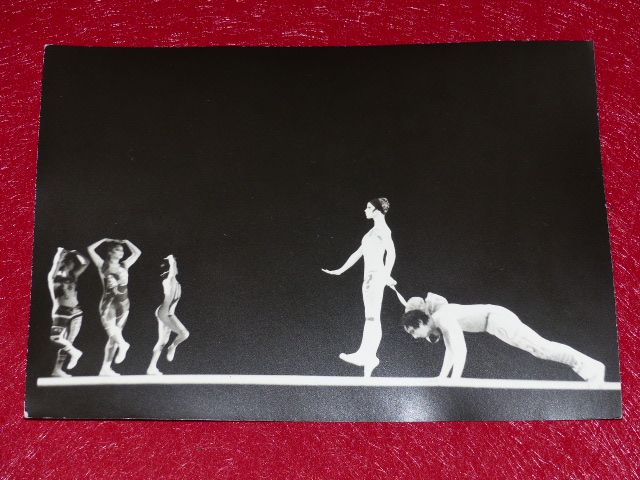
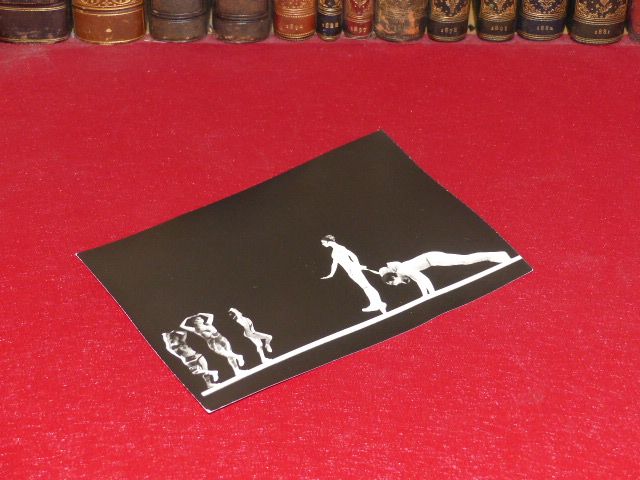
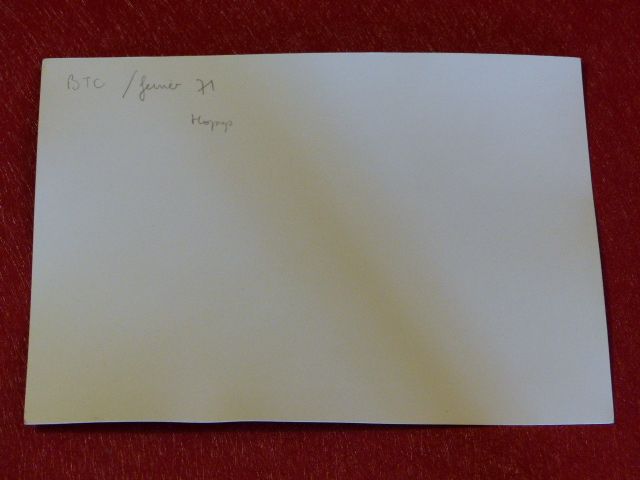
Below is the extremely rare original poster of the show
(120x80 cm, only 1 copy, on sale in my ebay shop, if it has not already been purchased...)
<meta http-equiv="Content-Type" content="text/html; charset=UTF-8"><meta name="viewport" content="width=device-width, initial-scale=1.0">
<styling>
img {
max-width: 100%;
}
</style>
